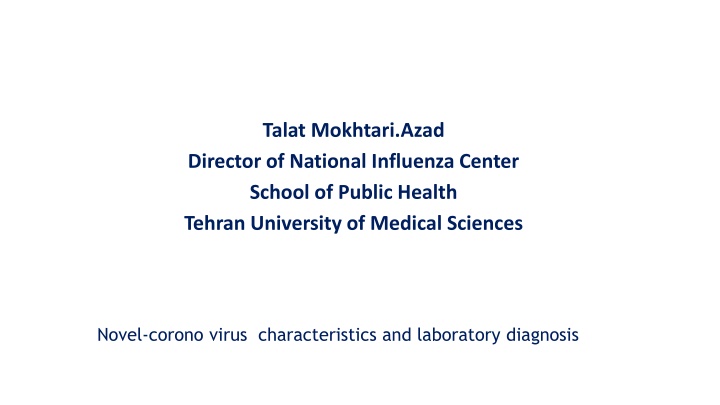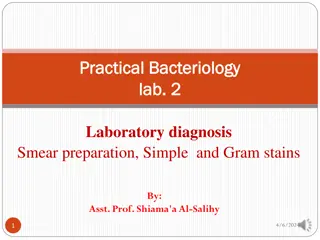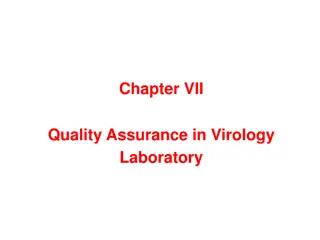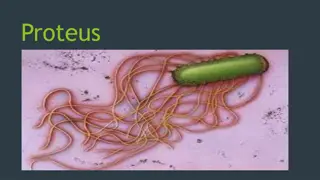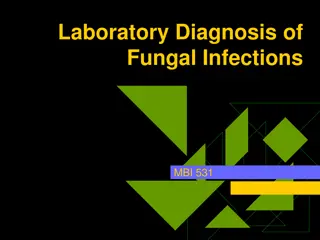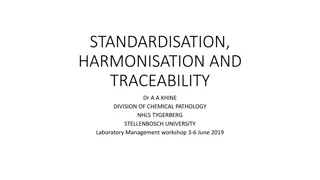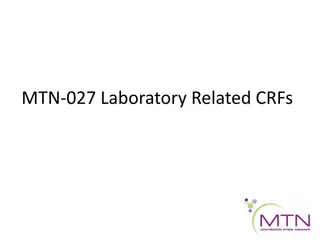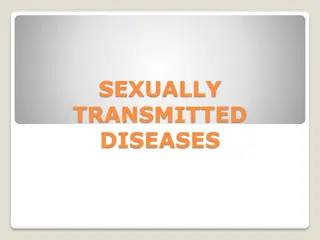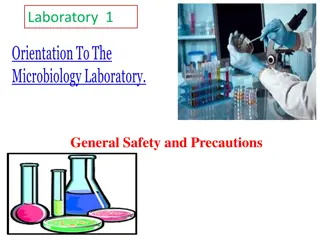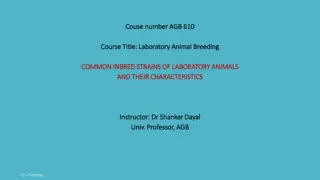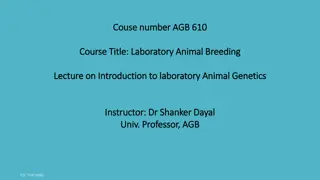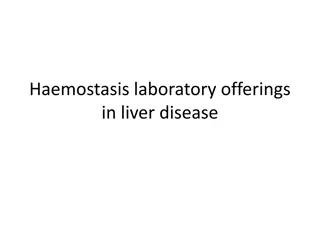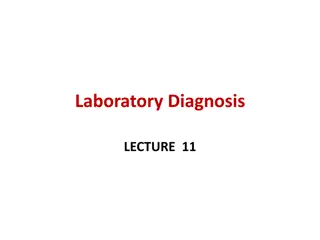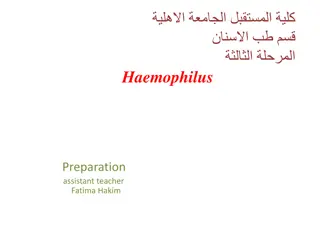Characteristics of Coronaviridae and Laboratory Diagnosis
Coronaviridae is a family of enveloped, positive-sense RNA viruses with distinct spike projections. Learn about their structure, classification, and why new viruses emerge. Understand the importance of laboratory diagnosis and prevention strategies for diseases like SARS, H1N1, Zika, Ebola, MERS, and N-Cov. Explore the impact of these emerging diseases on global health and examine the genetic lineage of human-associated coronaviruses.
Download Presentation

Please find below an Image/Link to download the presentation.
The content on the website is provided AS IS for your information and personal use only. It may not be sold, licensed, or shared on other websites without obtaining consent from the author.If you encounter any issues during the download, it is possible that the publisher has removed the file from their server.
You are allowed to download the files provided on this website for personal or commercial use, subject to the condition that they are used lawfully. All files are the property of their respective owners.
The content on the website is provided AS IS for your information and personal use only. It may not be sold, licensed, or shared on other websites without obtaining consent from the author.
E N D
Presentation Transcript
Talat Mokhtari.Azad Director of National Influenza Center School of Public Health Tehran University of Medical Sciences Novel-corono virus characteristics and laboratory diagnosis
Intoduction Intoduction Despite remarkable advances in medical science and treatment during 20th century, infectious diseases remain the leading cause of death worldwide Emerging disease is a disease that has never been recognized before. .During the last 20 years, at least 30 new infectious have emerged. These diseases are the leading cause of death worldwide, claiming at least 17 million lives every year. 2
Coronaviridae structure and classification Why do we have new viruses in this family Sensitivity to chemical material Laboratory diagnosis Control and prevention
Deduction Deduction SARS H1N1 Zika Ebola MERS H5N1 N-Cov 2000 2015 2020 2005 2010 4
Coronaviridae Coronaviridae is a family of: enveloped, positive-sense, single-stranded RNA viruses. The viral genome is 26 32 kilobases in length. Coronaviruses (CoVs) are characterized by club-shaped spike projections emanating from their surface of the virion, which in electron micrographs of spherical particles create an image reminiscent of the solar corona. The structure of CoVs comprises the spike (S), envelope (E), membrane (M), and nucleocapsid (N). The family Coronaviridae is organized in 2 sub-families, 5 genera, 23 sub-genera and about 40 species
Family: Family: coronaviridae coronaviridae Subfamily: Subfamily: coronavirinae coronavirinae Genus: Genus: a alpha, beta, gamma and delta coronaviruses lpha, beta, gamma and delta coronaviruses The Alphacoronoviruses: NL-63, 229E The Beta-CoVs of the greatest clinical importance concerning humans are: A lineage: OC43 and HKU1 B lineage: SARS-CoV and 2019-nCov C lineage:MERS-CoV The Alphacoronavirus and Betacoronavirus genera descend from the bat gene pool.
Human infection with coronaviruses is common, but they usually cause nothing more than a cold. A range of animals are also susceptible to coronaviruses, but these viruses do not tend to transmit to humans. However, in some cases, an animal coronavirus can jump from animal to human. For instance, the viruses that caused the severe acute respiratory syndrome (SARS) outbreak in 2003 and the Middle East respiratory syndrome (MERS) outbreak in 2012.
Full genome tree of all Coronavidae families Red BetaCoV 2019-2020 Blue SARS CoV Purple MERS CoV Green common cold CoV Phylogenetic tree shows virus is not close to common cold coronaviruses and only distantly related to SARS-CoV; The available sequence also informs diagnostics efforts.
Orange bat RaTG13 Red BetaCoV 2019-2020 Blue SARS CoV Purple MERS CoV Green common cold CoV BetaCoV 2019-2020 Genome identity to BetaCoV: 96% RaTG13 (nearest bat precursor) 88% ZC45/ZXC21 bat precursor 80% SARS
Genome identity to BetaCoV: 96% New nearest bat precursor 88% Previous nearest bat precursor 80% SARS
Receptor binding surveillance for current sequences Receptor binding surveillance for current sequences Cyan ACE2 human host receptor Gray CoV spike glycoprotein Spike glycoprotein variation so far: H58Y Guangdong/20SF028/2020|EPI_ISL_4 03936|2020-01-17 Guangdong/20SF040/2020|EPI_ISL_4 03937|2020-01-18 F41I Wuhan/HBCDC-HB- 01/2019|EPI_ISL_402132|2019-12-30 No mutation near the binding No mutation near the binding interface so far interface so far Surface proteins are 76% and 98% identical, respectively Antigenic surface highly divergent compared to SARS Bat precurser differences in receptor binding interface indicative of changes that We gratefully acknowledge the Authors from Originating and Submitting laboratories of sequence data on which the analysis is based. by BII, A*STAR Singapore allowed host switch
Why do we have new viruses in this family Coronaviruses are zoonotic, meaning they are transmitted between animals and people.Several known coronaviruses are circulating in animals that have not yet infected humans. An unusually large RNA genome 26-32 kb , and In comparing with the genomes of all other RNA viruses have the largest genome. coronavirus genomes contain cis-acting RNA elements that ensure the specific replication of viral RNA Like other RNA viruses has the potential for mutation.
Specimen Collection Throat swabs is routine specimen but some times we receive endotracheal aspirates or bronchoalveolar lavages or necrospy. Use only sterile dacron, rayon or polyester fibre swab. We know that cotton swabs, or swabs with wooden stick should not be used because they may contain substances that inactivate some viruses and inhibit PCR testing but some time if they have not access to the dacron swab may use cotton swab.
Viral Transport Media NIC prepare VTM for country Patient specimen with ID
Samples to be collected (see Table Samples to be collected (see Table 1 1 for details on sample collection and collection and storage for details on sample storage Respiratory material: nasopharyngeal and oropharyngeal (dacron or polyester swabs in VTM). endotracheal aspirate or bronchoalveolar lavage in patients with more severe respiratory disease (sterile container with VTM) Sputum Sterile container
Information to be recorded: name, date of birth, sex and residential address, unique identification number, other useful information (e.g. patient hospital number, surveillance identification number, name of hospital, hospital address, room number, physicians name and contact information, name and address for report recipient), Date and time of sample collection, Anatomical site and location of specimen collection, Tests requested, Clinical symptoms and relevant patient history (including vaccination and antimicrobial therapies received, epidemiological information, risk factors).
Laboratory Diagnosis Laboratories may desire to use a pan-coronavirus assay for amplification followed by sequencing of amplicons from non- conserved regions for characterization and confirmation. The importance of the need for confirmation of results of testing with pan-coronavirus primers is underscored by the fact that four human coronaviruses (HcoVs) are endemic globally: HCoV-229E, HCoV-NL63, HCoV-HKU1 as well as HCoV-OC43. Alternatively, amplification and detection of 2019-nCoV specific sequences can be diagnostic without the necessity for further sequencing.
Coronaviridae genes for diagnosis First line screening assay: E gene assay Confirmatory assay: RdRp gene assay
Diagnostic knowledge gaps Diagnostic knowledge gaps Molecular testing What are the best clinical specimens for optimum RT-PCR yield and identification of cases? What is the excretion pattern of the virus and when is the best time for sampling? How long after recovery do individuals shed the virus, and from which anatomical sites? What is the range of genetic diversity among 2019-nCoV isolates? Will this diversity affect test performance (nucleotide changes in the primer/probe binding region)?
a) Both influenza A and B viruses survived for 24-48 hours on hard, nonporous surfaces such as stainless steel and plastic Survived for <8-12 hr on cloth, paper, and tissues. Virus survived on hands for up to 5 min after transfer from the environmental surfaces. Transmission of virus from donors who are shedding large amounts could occur for 2-8 hr via stainless steel surfaces and for a few minutes via paper tissues b) c) d) SARS-Co V was completely inactivated by heating at 56 C for 60 min or longer. The combination of spraying and wiping the bench with 70% ethanol, followed by UV irradiation may completely inactivate any virus on the bench. Environmental cleaning: 1:10 bleach solution
how how to wear a medical mask properly, following WHO guidelines. to wear a medical mask properly, following WHO guidelines. Use medical masks only once, then throw them in a safe, covered trash can. Wearing a mask must cover both the nose and mouth. When wearing a mask, do not touch your hands to avoid hands being infected with viruses and other pathogens, then spread the disease to yourself and others. When removing the mask, only hold the strap by the ear, not the mask, then put it in the safe trash. Immediately after discarding the mask, wash your hands with soap and clean water.
For the general public, no additional precautions are recommended at this time beyond the simple daily precautions that everyone should always take. It is currently flu and respiratory disease season, and flu activity is still high and expected to continue for a number of weeks. Standard recommendations to prevent infection spread include regular hand washing, covering mouth and nose when coughing and sneezing, thoroughly cooking meat and eggs. Avoid close contact with anyone showing symptoms of respiratory illness such as coughing and sneezing.
